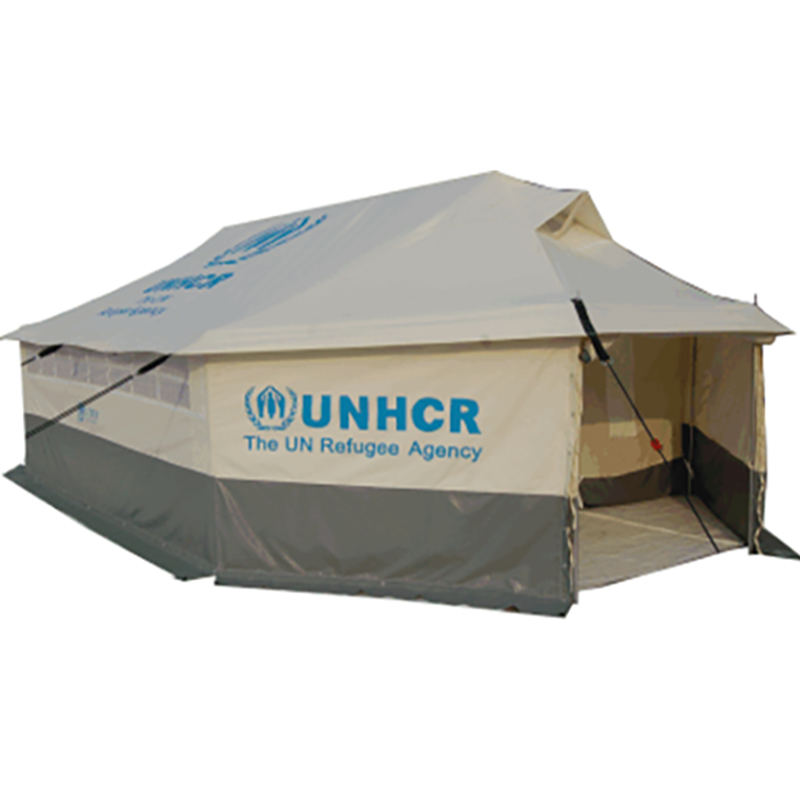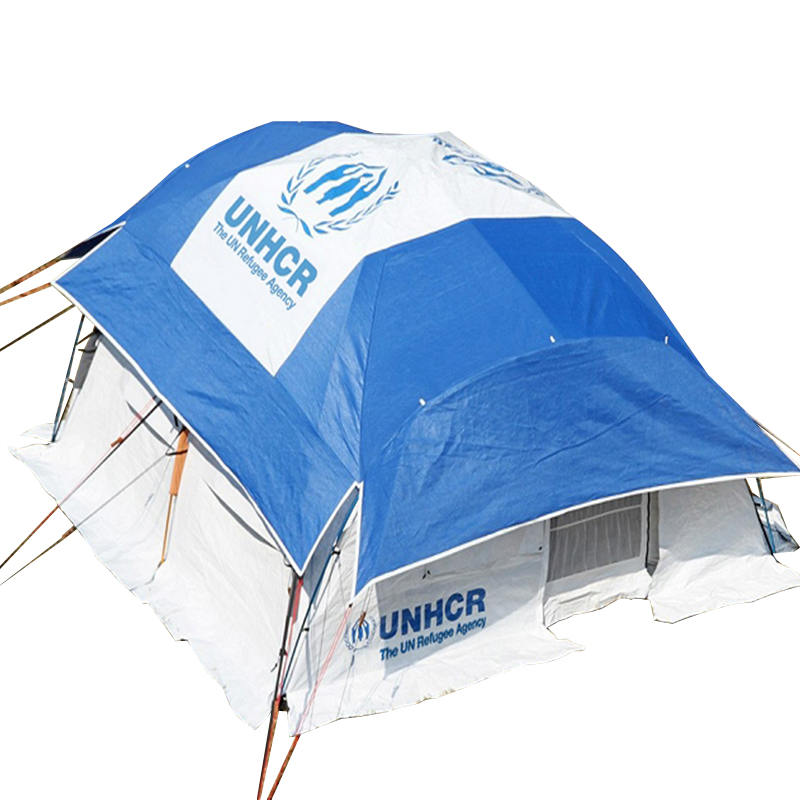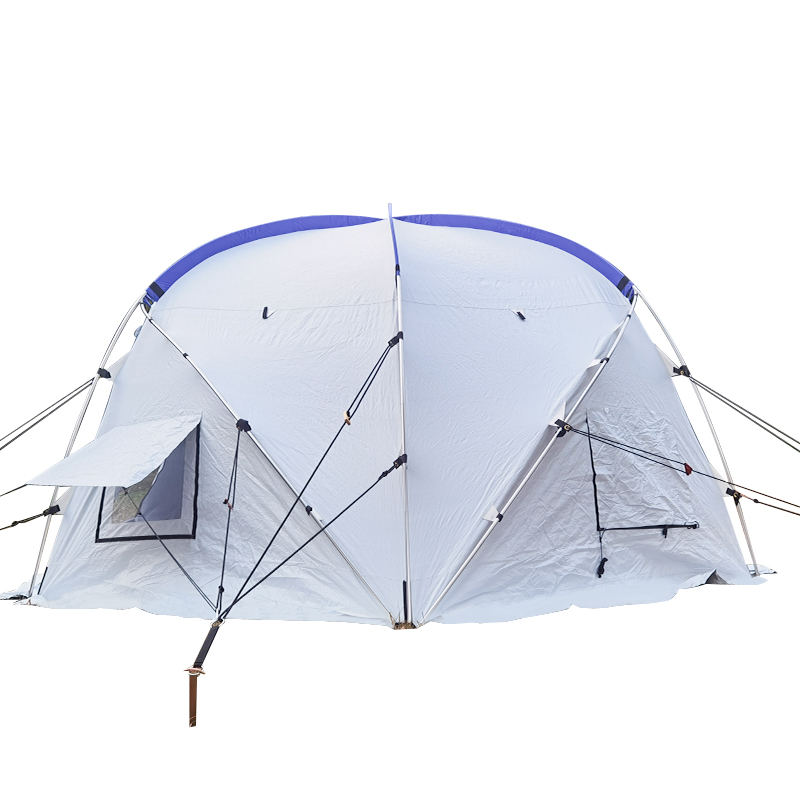Our story is about how to uphold the spirit of humanitarianism in the face of disaster, how to find solutions amidst challenges, and how to sow hope in despair.
Web Menu
Product Search
Exit Menu
Which Camping Tent Design Adapts to Extreme Weather?
Posted by Admin | 07 Nov
Content
- 1 1. What Tent Structure Designs Resist Strong Winds in Extreme Weather?
- 2 2. What Fabric and Coating Designs Keep Tents Waterproof in Heavy Rain or Snow?
- 3 3. What Insulation and Ventilation Designs Keep Tents Comfortable in Freezing Cold?
- 4 4. What Design Features Protect Tents From UV Rays and Overheating in Scorching Sun?
- 5 5. What Floor Design Prevents Moisture and Damage From Rough Terrain or Snow?
Camping in extreme weather—whether it’s heavy rain, strong winds, freezing snow, or scorching sun—requires a tent that can stand up to harsh conditions while keeping campers safe and comfortable. A poorly designed tent can turn a wilderness adventure into a risky ordeal, with leaks, collapses, or overheating ruining the experience (or worse). But with so many tent designs on the market, which ones are truly built to adapt to extreme weather? This article will explore key questions about tent design features, uncovering how elements like structure, fabric, and ventilation make a tent capable of handling nature’s harshest challenges.
1. What Tent Structure Designs Resist Strong Winds in Extreme Weather?
Strong winds are one of the most common and dangerous extreme weather conditions for campers—they can tear tent fabric, bend poles, or even blow a tent away entirely. The right tent structure is critical for wind resistance, as it determines how well the tent distributes wind force and stays anchored.
- Dome vs. Tunnel Structures: Dome tents (with curved poles forming a rounded shape) are excellent for wind resistance because their smooth, aerodynamic design lets wind flow over the tent instead of catching on flat surfaces. The curved poles also distribute tension evenly across the fabric, reducing the risk of tears. Tunnel tents (long, cylindrical shapes with multiple poles) are also wind-resistant, especially when pitched with the entrance facing away from the wind—their elongated shape minimizes wind drag, and the multiple poles add stability. Both designs are far more windproof than flat-roofed or A-frame tents (which have sharp angles that catch wind and create pressure points).
- Pole Material and Quantity: Wind-resistant tents use strong, flexible poles—typically made of aluminum alloys or carbon fiber. These materials can bend slightly under wind pressure without breaking, unlike cheaper fiberglass poles (which are brittle and prone to snapping). The number of poles also matters: more poles mean more support points, which helps the tent maintain its shape in strong gusts. For example, a 4-season dome tent may have 4-6 poles (compared to 2-3 poles for a 3-season tent), with extra cross-poles reinforcing the roof and sides.
- Anchoring Systems: Even the best structure won’t hold without proper anchoring. Wind-resistant tents come with heavy-duty stakes (thick, sharp aluminum or steel stakes that dig deep into soil or snow) and strong guy lines (nylon or polyester ropes that attach to the tent’s rainfly and poles). Some tents also have “wind skirts” (fabric flaps that extend from the tent base and can be buried in snow or weighted with rocks) to prevent wind from blowing under the tent and lifting it.
For campers facing windy conditions (like mountain camping or coastal trips), a dome or tunnel structure with strong poles and a robust anchoring system is essential.
2. What Fabric and Coating Designs Keep Tents Waterproof in Heavy Rain or Snow?
Heavy rain, sleet, or melting snow can quickly soak through a tent if it’s not properly waterproof—leading to wet sleeping bags, ruined gear, and uncomfortable nights. Tent fabric and its coatings are the first line of defense against moisture, and their design directly impacts waterproof performance.
- Fabric Weight and Density: Waterproof tents use thick, dense fabrics—usually polyester or nylon—with a high denier rating (a measure of fabric thickness). A denier rating of 70D or higher (for the tent body) and 150D or higher (for the rainfly, which is the outer waterproof layer) is ideal for extreme rain. Thicker fabrics are more resistant to tearing and less likely to stretch (which can create gaps where water seeps in). For snow, even thicker fabrics (200D+) are better, as they can withstand the weight of snow without sagging or tearing.
- Waterproof Coatings: The fabric itself is treated with waterproof coatings to block moisture. The most common coating is polyurethane (PU), which is applied to the inside of the tent fabric. A PU coating with a waterproof rating of 2,000mm or higher (measuring how much water pressure the fabric can withstand before leaking) is suitable for heavy rain—4-season tents often have PU ratings of 5,000mm or more. Some tents also use silicone coatings (applied to the outside of the rainfly), which are more durable than PU and better at repelling water (water beads up and rolls off instead of soaking in).
- Seam Sealing: Even waterproof fabric can leak through seams (where pieces of fabric are stitched together), as stitching creates tiny holes. Waterproof tents have “taped seams”—special waterproof tape applied to the inside of seams to seal these holes. For extreme weather, look for tents with “fully taped seams” (all seams, including those on the rainfly and tent body, are taped) instead of “spot-taped seams” (only critical seams are taped). Some tents also have “heat-sealed seams” (tape applied with heat to create a stronger bond), which are more durable than adhesive tape.
For campers facing heavy rain or snow (like winter camping or rainy forest trips), a tent with thick, coated fabric and fully taped seams is a must.
3. What Insulation and Ventilation Designs Keep Tents Comfortable in Freezing Cold?
Freezing temperatures (below 0°C) present a unique challenge: tents need to retain heat to keep campers warm, but they also need to prevent condensation (moisture from breath or sweating that freezes inside the tent). The right insulation and ventilation design balances these two needs, ensuring comfort in the cold.
- Insulated Tent Bodies: 4-season tents (designed for winter use) often have insulated tent bodies—either a double-layer design (with a thin insulation layer between the inner and outer fabric) or a single layer with a thick, thermal fabric. The insulation traps body heat inside the tent, keeping the interior 5-10°C warmer than the outside temperature. Some tents also have insulated floors (thick, foam-padded floors) to prevent cold from seeping up from the ground—critical for campers sleeping on snow or frozen soil.
- Ventilation That Prevents Condensation: While insulation retains heat, poor ventilation leads to condensation (which freezes on the tent walls and drips onto gear). Winter tents solve this with “adjustable ventilation ports”—small windows or vents on the tent’s roof or sides that can be opened slightly to let moist air escape. These vents are covered with mesh (to keep out snow and wind) and can be closed if the wind picks up. Some tents also have “chimney vents” (tall, covered vents that rise above the tent roof) that draw warm, moist air out without letting cold wind in.
- Rainfly Design for Heat Retention: The rainfly (outer layer) of winter tents is designed to fit tightly around the tent body, reducing the gap between the rainfly and inner tent. This minimizes cold air circulation between the layers, helping the tent retain heat. Some rainflies also have “snow flaps” (extra fabric along the bottom) that can be buried in snow to create a seal, further trapping heat inside.
For winter campers or those facing freezing temperatures, an insulated tent with adjustable ventilation ports and a tight-fitting rainfly will keep them warm and dry.
4. What Design Features Protect Tents From UV Rays and Overheating in Scorching Sun?
Extreme heat (temperatures above 30°C) can be just as challenging as cold—tents can become hot, stuffy greenhouses, and UV rays can fade or weaken fabric over time. Tent designs for hot weather focus on reflecting UV rays and maximizing airflow to prevent overheating.
- UV-Resistant Fabrics and Light Colors: Hot-weather tents use fabrics treated with UV-resistant coatings (to block harmful UVA and UVB rays) and are often colored light (white, beige, or light gray). Light colors reflect sunlight instead of absorbing it, keeping the tent interior 10-15°C cooler than dark-colored tents. The UV coating also protects the fabric from degradation—preventing it from becoming brittle and tearing after prolonged sun exposure.
- Mesh Panels and Open Designs: Airflow is key to staying cool, so hot-weather tents have large mesh panels (on the tent body, doors, and windows) that let fresh air circulate while keeping out bugs. Some tents even have “screen rooms” (attached mesh enclosures) where campers can sit outside without being bitten by insects. Tunnel tents are particularly good for hot weather because their long shape creates a cross-breeze when both ends are open, while dome tents with multiple mesh windows also promote airflow.
- Rainfly as a Sun Shade: In hot weather, the rainfly can be used as a sun shade—pitched slightly above the tent body (instead of tight against it) to create a gap where hot air can escape. Some rainflies are designed with extra fabric that extends over the tent doors, providing shade for the entrance and reducing sunlight entering the tent.
For campers in deserts, tropical regions, or summer trips with intense sun, a light-colored, UV-resistant tent with large mesh panels and a sun-shade rainfly is essential.
5. What Floor Design Prevents Moisture and Damage From Rough Terrain or Snow?
The tent floor is often overlooked, but it’s critical for protecting campers from moisture (wet soil, melting snow) and rough terrain (rocks, sticks, or sharp ice). A well-designed floor keeps the tent interior dry and prevents tears that can ruin the tent.
- Thick, Durable Floor Fabrics: Extreme-weather tents have thick, puncture-resistant floor fabrics—usually a blend of nylon and polyester with a denier rating of 200D or higher. Some floors are also “reinforced” (with extra fabric layers in high-wear areas like under the sleeping bags) to prevent tears from rocks or sticks. For snow camping, floors may have a waterproof, ice-resistant coating that prevents the floor from sticking to frozen ground and tearing when the tent is moved.
- bathtub Floors: A “bathtub floor” (a floor that extends up the tent walls 6-12 inches) is a key feature for moisture resistance. This design prevents water from seeping under the tent (from rain or melting snow) and into the interior—unlike flat floors (which are flush with the tent walls and prone to leaks). The raised edges of the bathtub floor are also sealed to the tent body with taped seams, creating a watertight barrier.
- Insulated or Removable Floors: For winter camping, some tents have insulated floors (with foam or thermal layers) to keep cold from seeping up. For multi-season use, tents may have removable floors—thick, insulated floors for winter and thinner, lighter floors for summer. This versatility lets campers adapt the tent to different terrain and weather conditions.
A thick, bathtub-style floor is a must for any extreme-weather tent, as it protects against both moisture and terrain damage.
Adapting to extreme weather requires a camping tent designed with specific features for the conditions you’ll face: wind-resistant structures for gusts, waterproof fabrics and seams for rain/snow, insulation and ventilation for cold, UV protection and airflow for heat, and durable floors for rough terrain. There’s no “one-size-fits-all” extreme-weather tent—campers must match the tent design to their destination (mountain, desert, forest) and the weather they expect. By understanding the key design features outlined in this article, you can choose a tent that keeps you safe, dry, and comfortable—no matter what nature throws your way. Whether you’re winter camping in the mountains or summer camping in the desert, the right tent design will turn extreme weather into just another part of the adventure.
Related Products
- Cell Phone:+86 15695147631
- Cell Phone:+86 18630605111
-
Email:
[email protected]
[email protected]
[email protected] - Add:No.9 Kangmin Road, Automobile industry Park, Yizheng City, Jiangsu Province, China
Copyright © Yangzhou Mailenda Outdoor Products Co., Ltd.
All Rights Reserved.
Custom Tent OEM/ODM Manufacturers

- Privacy Statement
- Terms & Conditions
- Sitemap


 English
English 中文简体
中文简体 Español
Español 日本語
日本語 русский
русский عربى
عربى






